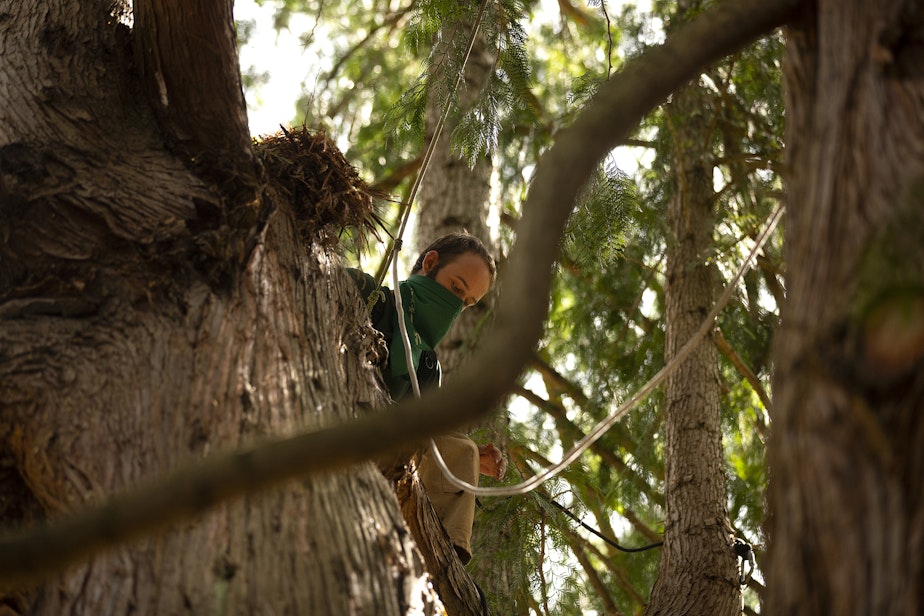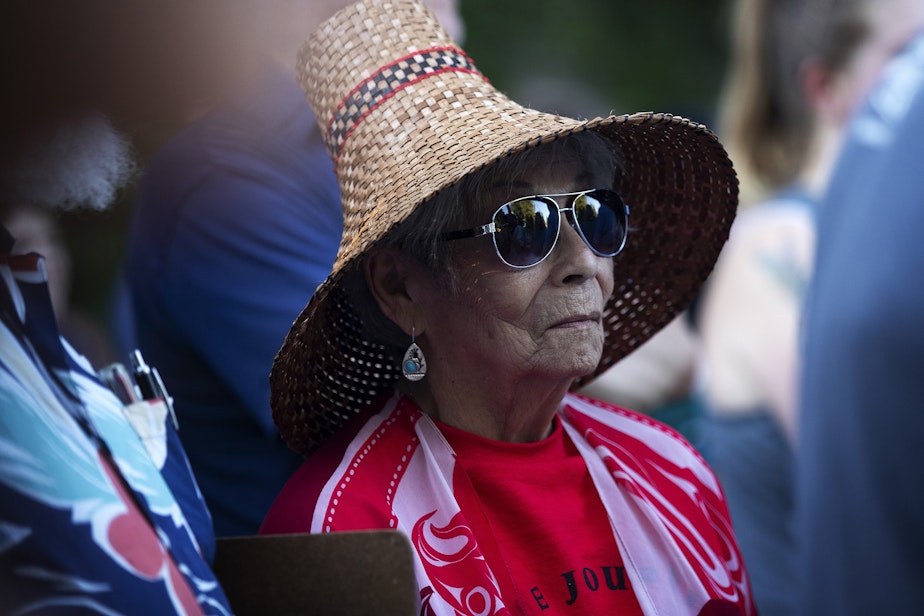How Luma, an ancient cedar, has transfixed Seattle
Seattle is a young racehorse of a city, a mere babe at 172 years old, who propelled herself through the jet age and now a tech boom, amassing wealth and dreamers and high rises and artisanal bakeries that sell $11 loaves and no one bats an eye.
She is a city whose residents haven’t, until recently, reflected on the past, because past is footnote here, because present is a blur, and anyway, what was in that spot before? A parking lot? We don’t remember.
But recently, an undercurrent of nostalgia has gripped the city, along with an uneasy feeling that old Seattle is vanishing, and that the liberal values she professes may not match the capitalist reality she manifests. Nowhere is that more present right now than in Wedgwood, a sleepy neighborhood in northeast Seattle, where neighbors and activists and tribal members have rallied around a cedar tree they call Luma.
Luma, believed to be 120 to 200 years old, was a sapling when white settlers arrived here. Now reaching eight stories high, the tree oozes a sticky sap that glints gold, and boasts a trunk so thick that it would take four people, arms spread wide and fingers touching, to embrace it.
Luma is also in danger of being cut down.
RELATED: Snoqualmie Tribe says Wedgwood protest is about more than one tree
For years, Luma shared a 10,000-square-foot lot with a massage therapist and his house. Last year, the massage therapist sold his property to developers, Rock House Builders in Des Moines, Washington, who tore it down with plans to build six new homes. The original drawing shows Luma still standing.
Sponsored
The story would be a triumph if it ended here, an example of Seattle preserving its tree canopy while providing more housing to a city that desperately needs it.
But the developers changed their mind about Luma. Tree advocates, already concerned about the city’s dwindling tree canopy, spotted the permit to fell the giant evergreen, and activated their network.
“We used to have modest homes under the trees,” said Meegan McKiernan, an activist who grew up nearby. “We lived with the trees. Yes, we need to build more housing, but this could still be six homes with the tree.”

Sponsored
The activists repeat this refrain, seemingly anxious that they may be perceived as NIMBYs opposed to more housing in an explosively expensive city, where the number of people living in tents seems to grow every day.
The activists say that cutting down trees hastens the impact of climate change, pointing to Georgetown, South Park, and nearby Lake City as neighborhoods where the topography was razed, turning them into heat islands. These are neighborhoods where people are less likely to afford air conditioning, and where at least 10 people died during the heat wave of June 2021, according to medical examiner data.
Last week, a man nicknamed Droplet climbed up Luma in the hopes of saving her. He nudged out some grumpy raccoons and stayed for days. (“The waste can goes up and down, and the food can goes up and down – just don’t get them confused,” McKiernan said.)
Droplet was relieved by another Droplet, a woman who debated her own nickname but decided to go with Droplet, to limit the focus on tree-sitters.
On Thursday afternoon, Droplet the Second straddled a bough and shouted down to a reporter, “I have stories to tell you!” She told of life on Luma: a hummingbird staring at her when she woke up (“like, what are you doing here?”), a woodpecker-like bird, and swarm of mosquitoes that reminded her of the Mosquito Fleet of kayaks that chased a Shell oil rig out of Elliott Bay in 2015.
“Luma has an email, an Instagram account and one of those Google business accounts,” Droplet said. “She has a five-star rating.”
Sponsored

Luma’s social media presence reached the Snoqualmie Tribe, whose ancestors walked through Wedgwood to reach Puget Sound. Seeing photos of Luma, tribal members wondered if the tree’s upward turning branches meant she was a culturally modified tree.
Such branches suggest “an ancient indigenous trail system connecting Puget Sound to Lake Washington,” the Snoqualmie Tribe told the city in a letter sent on July 19.
Cancel the permit to cut down Luma, the tribe asked. In a press release, the tribe said, “Seattle, a city that often apologizes for past injustices inflicted upon Indigenous peoples, shows a shocking level of indifference and dismissiveness toward the harm it is currently causing by desecrating this tribal archaeological site.”
Protecting trees is not at odds with building more housing, nor is it necessarily more expensive, said John Hushagen, a retired Seattle arborist (and, full disclosure, my best friend’s dad; we grew up blocks from Luma.)
Established trees make property more valuable, Hushagen explained. Trees similar to Luma have added $40,000 to $60,000 to a property.
Hushagen said that developers would prefer to build on a standard spread footing by digging a straight trench. But there is an alternative, he said, called pin pilings, which would add roughly $40,000 to the building cost.
“It’s more expensive, but it’s equal to the tree’s value,” he said.
Sponsored
Sponsored

Alex Ayegba, the arborist hired to cut down Luma, said it wasn’t worth it to him, either. He attended a vigil for Luma on Tuesday evening.
After hearing Snoqualmie and Duwamish tribal members speak of their connection to Luma, Ayegba, a Nigerian immigrant, decided to drop the job.
“I saw love from the community. I couldn’t go ahead with it,” Ayegba said. “When they talked about the Native American connection to the trees – in Africa, we have a similar tradition, our ancestors are living with us in whatever form.”
He said that among his company’s core values is “people over money.”
“It’s not worth hurting the community over,” he said. “It’s just one job.”




